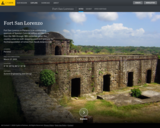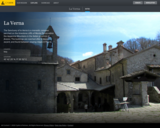
1846 CE, Formidable Fort of the U.S.-Mexican War
- Subject:
- Architecture
- Arts and Humanities
- CTE
- United States history
- World history
- Date Added:
- 06/06/2017


1846 CE, Formidable Fort of the U.S.-Mexican War

1595 CE - 1821 CE, Panama's Colonial Era Gateway between the Atlantic and Pacific Oceans

1857 CE - 1878 CE, A Reminder of a History of Fire

1426 CE - 1970 CE, Great Barn of the British Isles

1718 CE - 1900 CE, Historic Cities

1682 CE - 1900 CE, Historic Cities

1720 CE - 1797 CE, The Hermitage at Houghton Hall

1838 CE - 1844 CE, Hawaiian Royalty Palace

300 BCE - 100 BCE, Rare, Surviving, Etruscan Tomb in Italy

1911 CE - 1913 CE, Dream Home of Author Jack London

1700 CE - 1718 CE, The Jamia Mosque, known as Jamia Masjid Khudabad or Badshahi Masjid, is situated in Khudabad, Dadu, Sindh and was built during the reign of Yar Mouhammed Kalhoro between 1700 and 1718.

100 CE - 400 CE, The early evolution and spread of Buddhism - The Buddhist monastery and associated stupas of the Jaulian archaeological complex shed light on the early evolution and spread of Buddhism along the Silk Road. The site was constructed between the 2nd and 4th centuries CE and is located in the Khyber Pakhtunkhwa Province of Northern Pakistan, part of the ancient Kingdom of Gandhara. Jaulian is one of many Buddhist sites constructed throughout the region during the Kushan period which was marked by general prosperity, a cosmopolitan mix of cultures, and state support of architecture.

900 BCE - 146 BCE, The amphitheaters found around the Mediterranean are one of the most important legacies left from ancient civilizations. Their architecture, acoustics, and quality of structure give clue to their social importance and craftsmanship. As important as they were historically, they are equally as important now to the living legacy from tourists to local performers. However, it is also this continued interest that has become a contributing factor to the deterioration of these sites. ATHENA Project

1838 CE - 1849 CE, John Muir's Birthplace attracts around 15,000 visitors of all ages each year from all over Scotland and the rest of the world. Some come as pilgrims to visit the birthplace of their inspiration while others come with little knowledge of Muir. They all learn more about John Muir's life and legacy, are encouraged to participate in conservation and to follow in Muir's footsteps.

1849 CE - 1914 CE, John Muir worked, raised a family and wrote in his Martinez, California home.

1213 CE - 1459 CE, Franciscan Sanctuary of La Verna

1914 CE - 1922 CE, This titan of American national heritage grew up as a poor boy on the frontier. Reading books by candlelight, whether after long hours at school or on the farm, proved invaluable to young Lincoln. He later served as a store clerk, a river trader, and a "rail-splitter" used to hard physical labor. A plain speaker for plain folks, Lincoln blended his love of the written word with a strong work ethic and pursued a legal career, then a political one from the Illinois state legislature to the U.S. Congress. Here was a man who aspired to lead a nation.

1858 CE - 1876 CE, Our Lady of Lourdes Grotto

17th - 18th Century, The Lukang Lonshan temple is both the largest temple in Lukang, a large coastal city in Western Taiwan and the most well-preserved buildings dating from the Qing Dynasty in the country. The site is considered is a national monument and is revered by many Taiwanese. The temple was damaged in an earthquake in September of 1999 and suffered extensive damage to several important structural features.

1892 CE - 1963 CE, Gothic Art in the Gilded Age